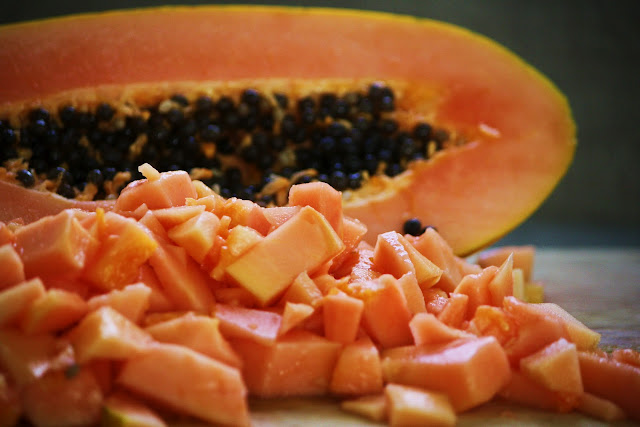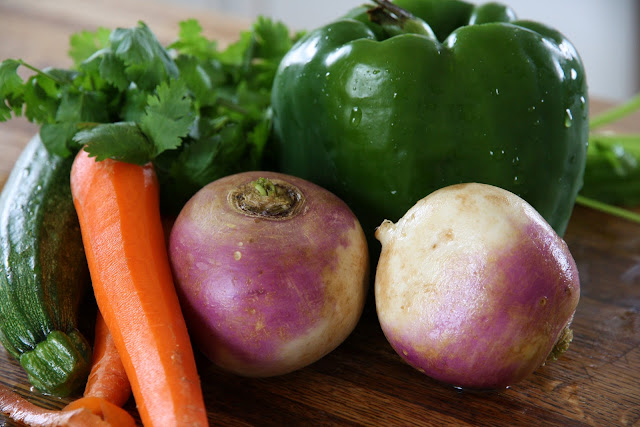When I was kid, my Mom always had marmalade in the house. Golden-orange, glistening and sweet on the front of the tongue, tart half way through, and then just a hint of bitterness at the back, it was full of chewy slivers of Seville orange rind that released a heavenly orange blossom scent; this was real grown-up orange marmalade. Nothing Smuckers about it. As was her ritual, she would decant the marmalade from the store-bought container into a beautiful, antique cut-glass jam jar with a hinged sterling silver lid and matching spoon, which made spreading it all the more elegant. And, as was also her habit, she had it almost every morning on crispy toast with whipped sweet unsalted butter. A more beautiful accompaniment to black coffee does not exist. So, while this Pacific Islands recipe from the tiny island nation of Tuvalu is considerably sweeter (and more tropical) than the marmalade of my childhood memories, it has the very same sensory and and olfactory qualities that immediately awaken the senses in a distinctly foodgasmy kind of way. Now what could be bad about that?
 A Polynesian island nation (formerly known as the Ellice Islands) in the Pacific Ocean, Tuvalu sits midway between Hawaii and Australia. Comprised of four reef islands and five atolls, it's closest maritime neighbors are Kiribati, Naru, Samoa and Fiji (all countries whose meals I've prepared!). Slightly more than 10,000 people live on this 10 square mile island, making it the 3th least populated and 4th smallest country in the world. Sadly, due to the earth's rising temperatures and global warming these low lying islands are experiencing increased risk of flooding and ecological damage that threatens their future existence.
A Polynesian island nation (formerly known as the Ellice Islands) in the Pacific Ocean, Tuvalu sits midway between Hawaii and Australia. Comprised of four reef islands and five atolls, it's closest maritime neighbors are Kiribati, Naru, Samoa and Fiji (all countries whose meals I've prepared!). Slightly more than 10,000 people live on this 10 square mile island, making it the 3th least populated and 4th smallest country in the world. Sadly, due to the earth's rising temperatures and global warming these low lying islands are experiencing increased risk of flooding and ecological damage that threatens their future existence.First inhabited by Polynesians, the country was sighted by Spanish explorer Alvaro de Mendana in 1568. . By the 19 century, the country became a British protectorate, but in 1974, the islanders voted for separate dependency status from Britain and separated from the Gilbert Islands (now known as Kiribati). Finally, in 1978, the islands became an independent commonwealth. Interestingly, this island has no military force or budget and relies on the Maritme Police Surveilance Unit as needed. Close monitary ties are maintained with New Zealand and Australia, and to a lesser degree with Japan, South Korea and the European Union.
Cuisine in Tuvalu is limited by the country's lack of fertile soil and the stress on fishing resources due to an increasing population. Pulaka, a tuber grown underground in composted soil is the main source of carbohydrates and fish, coconut crabs, turtle and sea birds supply protein. Bananas, breadfruit, coconut and coconut milk. In addition, only about 1,000 tourists per year visit the island due the country's remote location, so for the most part, simple, traditional food is the staple of Tuvalian people.
Dice a ripe pineapple
Dice a ripe papaya
I combined grated ginger, grated and zested lemon for texture and flavor
Lemon juice and sugar are the only additional ingredients
Combine everything in a pot, bring to a boil and cook until mixture reaches 244 F
A golden spoonful of marmalade lusciousness - eat as is, on toast or use on pork!
Papaya-Pineapple Marmalade (Recipe adapted from The Pacific Islands Cookbook)
2 cups finely diced ripe pineapple (2 lbs.)
2 cups diced ripe papaya
4 cups sugar
1-1 / 2 teaspoons grated lemon rind or lemon zest (½ lemon or more if you like it tart)
1 /4 cup lemon juice
1-2 tablespoons fresh grated ginger, if desired
Mix pineapple and sugar in large shallow saucepan and let stand while preparing the papaya.
Add papaya.
Add grated lemon rind and juice.
Bring slowly to boiling point and boil about 30 minutes until mixture sheets from spoon, or until temperature reaches 224º degrees Farenheit on a candy thermometer.
Pour into sterilized half-pint jars and seal.This marmalade does not keep longer than 6 months
© 2010-2011, What's Cooking in Your World? Sarah Commerford/All Rights Reserved





































